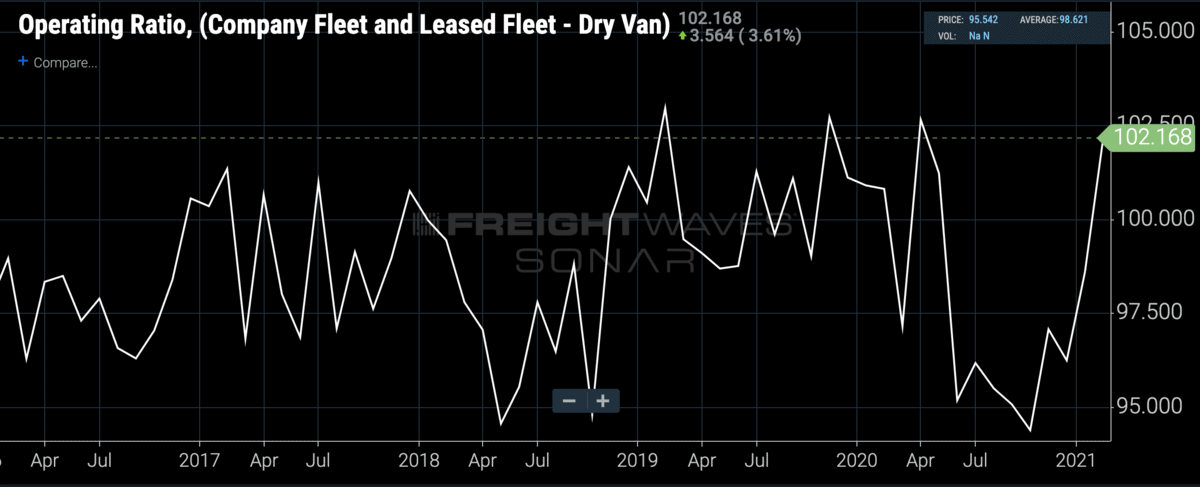Just what is operating ratio?
Operating ratio (OR) is a way for investors to compare the financials of one company against its peers. Investors use OR to gauge whether a company is generating sufficient profits.
The formula to calculate OR is to divide a company’s operating expenses by its revenue. Put differently, it is one minus the operating margin percentage. For example, a 20% operating margin is the equivalent of an 80% operating ratio. Operating expenses include items such as fuel, maintenance, and crew or employee costs, as well as toll expenses or maintenance-of-way costs. They also include equipment rentals.
“OR is a measure of efficiency. The lowest-cost provider with the lowest amount of operating expense wins the game,” said railroad economist Jim Blaze.
In this day and age, investors looking at the Class I railroads generally view an OR in the mid-50s as being a financial target for railroads to hit, although OR can generally range from 55% to 65%. The rail industry’s operating ratios have come down steadily over the years and are currently the best they have ever been. The Class I railroads are known for having a “good” OR because their relatively wide margins enable them to invest sufficient capital in their networks while also having positive cash flow left over to not only cover their debt and their dividend but to also repurchase large quantities of shares and raise the dividend over time. It might also mean they can pursue growth-oriented investments.
The trucking industry typically has a much higher OR, with large public carriers in the 90s and smaller, less sophisticated carriers close to 100 or even above 100. An outstanding OR for trucking would be in the 80s. An operating ratio above 100 means that the company’s revenue is not sufficient to cover its operating expenses, much less have profit left over for debt service or to return to shareholders. The trucking industry is a much more fragmented and competitive marketplace than the railroad industry; the associated lack of pricing power is the crux of why the operating ratios in the truck industry are typically higher than in the rail industry. In addition, the railroad industry is more capital-intensive (capital expenditures as a percentage of revenue) than trucking so wider margins are necessary to justify the major capital investments.

To learn more about FreightWaves SONAR, click here.
Some transportation modes might use operating margin instead of OR, but investors generally take it to mean the same thing.
“Transportation is historically a thin-margin business, and sometimes it has negative margins during cyclical downturns. So, it’s easier to think of it as 100% as margin breakeven,” said Mike Baudendistel, FreightWaves market expert for rail and intermodal.
What are the benefits of using operating ratios?
For starters, OR is relatively easy to calculate and provides easy comparisons between two companies.
“You can see whether one company has a cost structure that is highly elevated relative to another company that has a similar revenue mix,” Baudendistel said.
A high OR relative to peers is usually an indicator of being over-resourced and/or inefficient, or it might indicate a lack of discipline on prices or differences in a company’s business mix, Baudendistel added. Meanwhile, activist investors use OR to see which companies might have room for improvement or have the most fat to cut.
What are the downsides to using operating ratio?
Although ORs can provide a basic picture of a company’s financial performance, that picture can be incomplete. For instance, a railroad might decide to take on incremental intermodal business that might not carry as high a margin as other segments or commodities, and that ends up being reflected in a higher OR. So, even though that business can benefit a company’s cash flow and return on invested capital, that business can make the OR worse, according to Baudendistel.
One example of this is how the Class I railroad industry views and handles intermodal traffic. The ability to double-stack intermodal containers, first introduced in the U.S. in the early 1980s, paved the way for a 35% to 45% gain in productivity, according to Blaze. That helped lower the rail industry’s OR as well as improved the industry’s operating margin.
Nowadays, although intermodal margins may be lower than margins for other segments, such as chemicals, that doesn’t mean they’re inherently less valuable to a railroad.
“With intermodal being half of overall business volume, the Class I railroads have to be making high enough profit margins on intermodal,” Blaze said.
Meanwhile, there are other factors that might lead to a higher OR but that don’t necessarily mean a company is faring worse financially. A railroad might decide to be overstaffed or rent too much equipment in preparation of a volume surge. High fuel prices can also make the OR worse if the railroads capture the incremental fuel costs with higher fuel surcharges.
There is also the question of whether the drive toward OR pushes a company to cut its operating expenses too deep, and whether a lower OR benefits shippers in addition to investors.
Subscribe to FreightWaves’ e-newsletters and get the latest insights on freight right in your inbox.
Click here for more FreightWaves articles by Joanna Marsh.
Related links:
What is positive train control?







